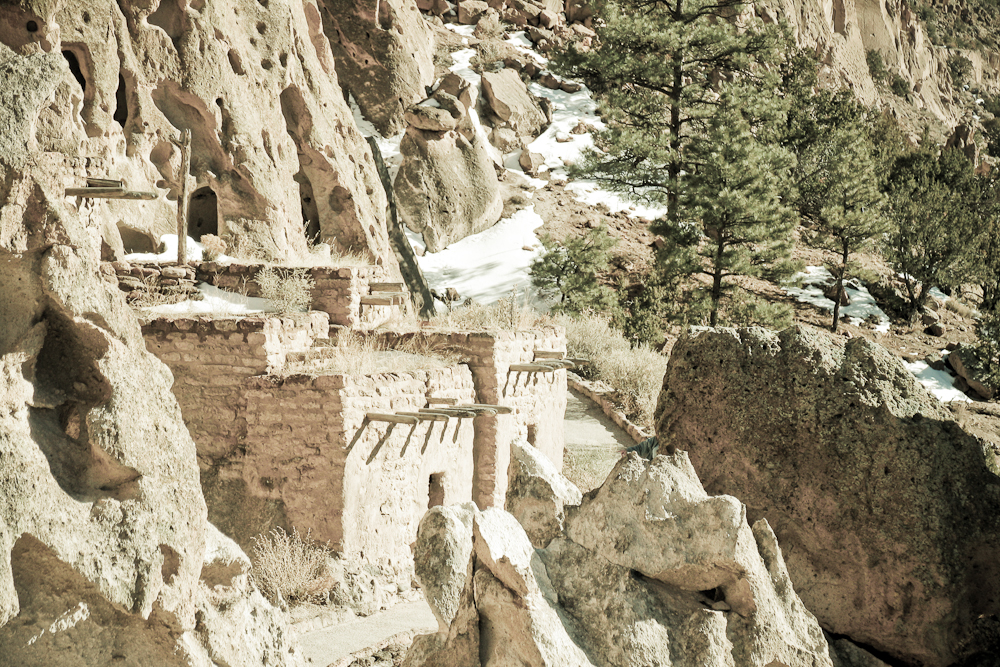

Bandelier was designated a National Monument on February 11, 1916, and the wilderness area was designated in October 1976.
The national monument is named after anthropologist Adolph Bandelier.
Several serious forest fires have plagued the monument in the latter part of the 20th century, culminating in the disastrous Cerro Grande Fire of 2000. This fire originated as a controlled burn for fire control but spread out of control owing to high winds, eventually burning over 40,000 acres (160 km²) of forest and destroying 250 homes in Los Alamos.
The main attraction of the monument for the casual visitor is Frijoles Canyon, containing a number of ancestral pueblo homes, kivas (ceremonial structures), rock paintings and petroglyphs. Some of the dwellings were rock structures built on the canyon floor; others were “cavates” produced by voids in the tuff of the canyon wall and enlarged by human action. A 1.2-mile (1.6 km), predominantly paved loop trail from the visitor center affords access to these features. A trail extending beyond this loop leads to Alcove House (formerly called Ceremonial Cave, and still so identified on some maps), a shelter cave produced by erosion of the soft tuff and containing a small, reconstructed kiva that the hiker may enter via ladder.
A large collection of structures at the monument were built during the Great Depression by the Civilian Conservation Corps, constituting the largest assembly of CCC-built structures in a National Park area that has not been altered by new structures in the district. This group of 31 buildings illustrates the guiding principles of National Park Service Rustic architecture.
Other, primitive trails enter the backcountry, which contains additional archaeological sites, canyon/mesa country, and some transient waterfalls. Hikes to many of these areas are feasible and range in length from short (<1 hour) excursions to multi-day backpacks (permits required for overnight trips). Unfortunately, some of the backcountry sites have been submerged, damaged, or rendered inaccessible by Cochiti Lake, a reservoir on the Rio Grande created to reduce seasonal flooding that threatened communities and agricultural areas downstream. A detached portion of the monument called the Tsankawi unit is near the town of Los Alamos and offers the day hiker a chance to see excavated sites and petroglyphs . Also at the Tsankawi unit are the remains of the home and school for indigenous people established by Baroness Vera von Blumenthal and her lover Rose Dougan (or Dugan). In the upper elevations of the monument, Nordic skiing is possible on a small network of trails reachable from New Mexico Highway 4. However, not every winter produces snowfall sufficient to allow good skiing. Wildlife is locally abundant, and deer and Abert's squirrels are frequently encountered in Frijoles Canyon. Black bear and mountain lions inhabit the monument but are rarely encountered, even by the backcountry hiker. A substantial herd of elk are present (and represent a significant driving hazard) during the winter months, as snowpack forces them down from their summer range in the Jemez Mountains. Notable among the smaller mammals of the monument are large numbers of bats that seasonally inhabit shelter caves in the canyon walls, sometimes including those of Frijoles Canyon near the loop trail, which is diverted as necessary to avoid the bat colonies. Wild turkeys, vultures, ravens, several species of birds of prey, and a number of hummingbird species are common. Rattlesnakes, tarantulas, and "horned toads" (actually a species of lizard) are occasionally seen along the trails.
Quoted from newmexico.org